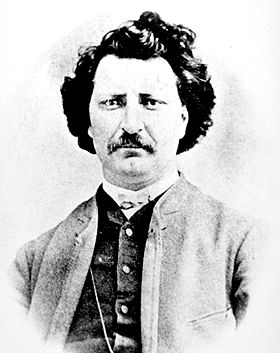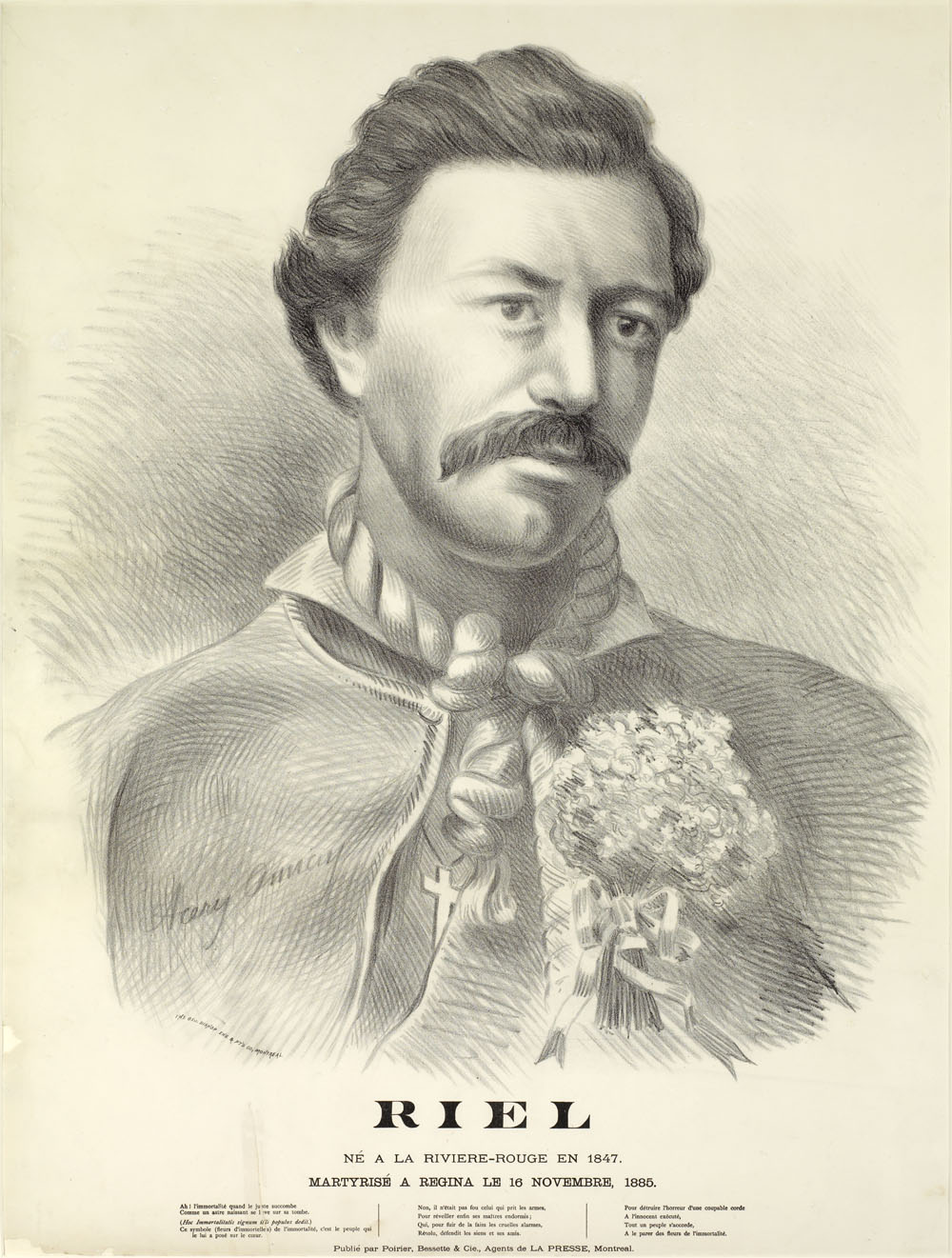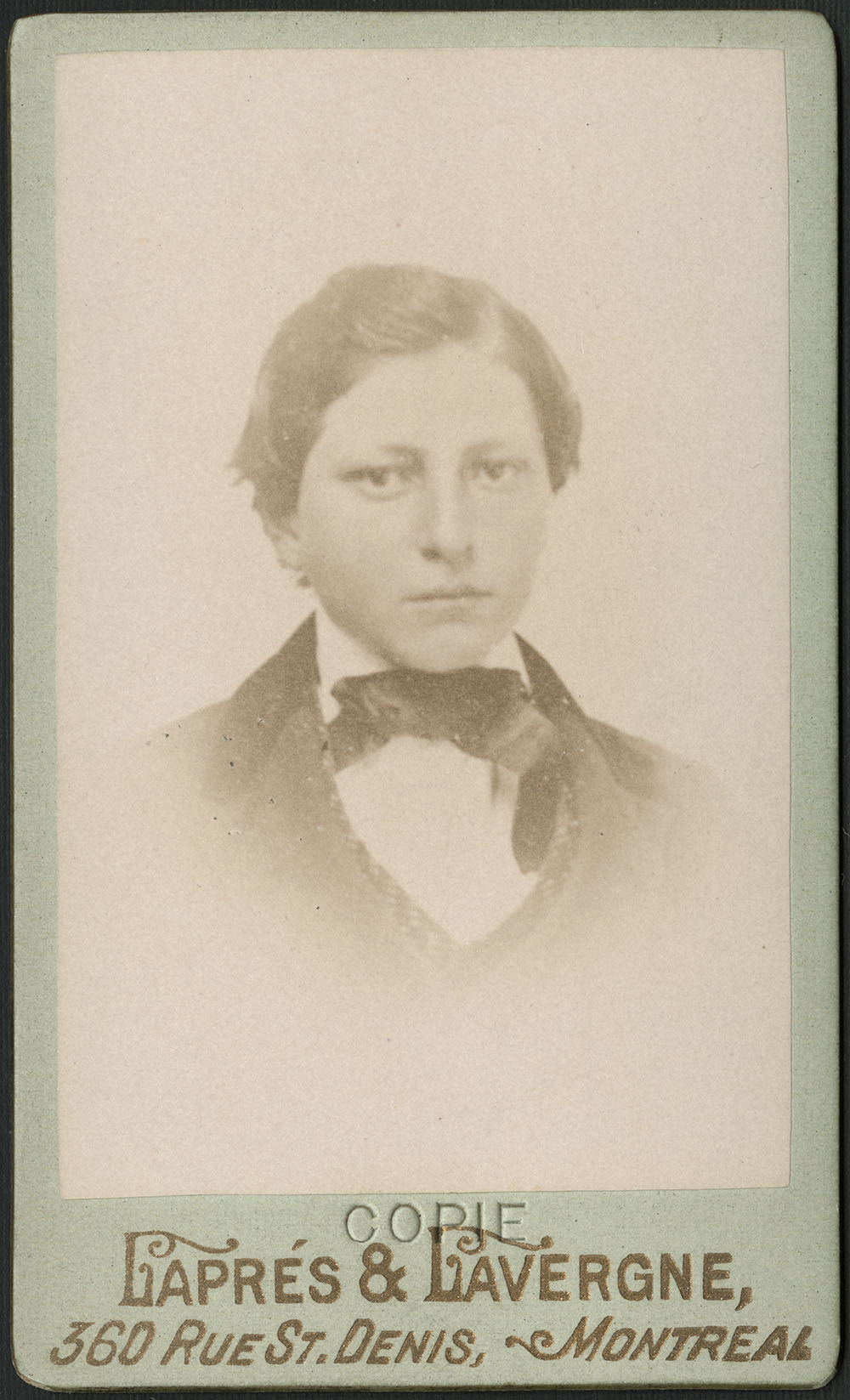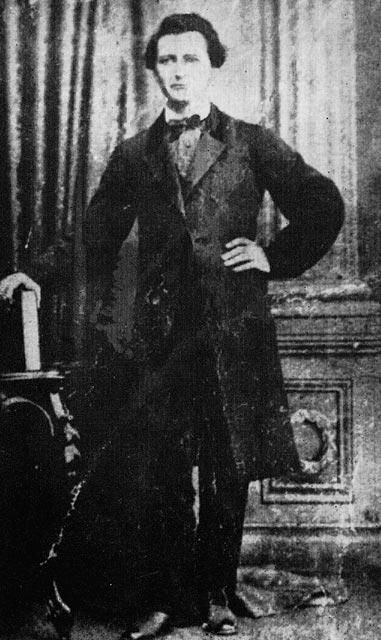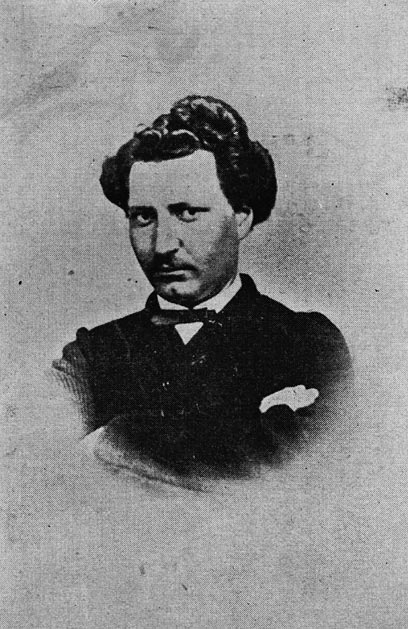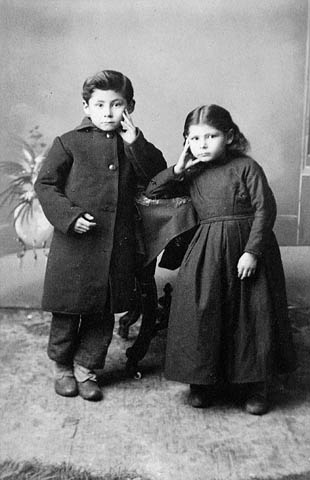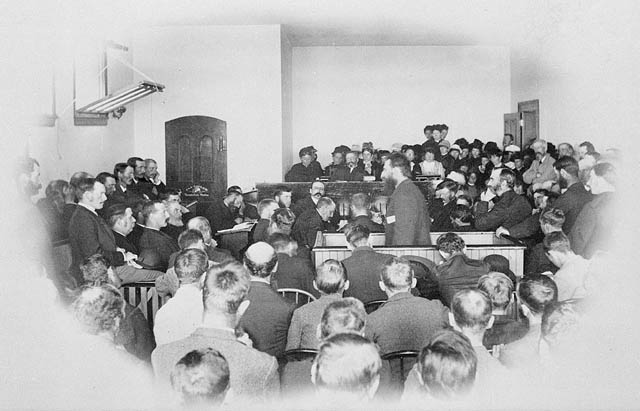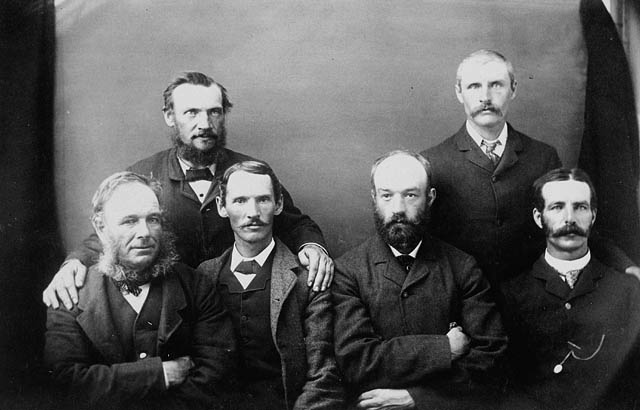Louis Riel, Métis leader, founder of Manitoba, central figure in the Red River and North-West resistance (born 22 October 1844 in Saint-Boniface, Red River Settlement; died 16 November 1885 in Regina, SK). Riel led two popular Métis governments, was central in bringing Manitoba into Confederation, and was executed for high treason for his role in the 1885 resistance to Canadian encroachment on Métis lands. Riel was initially dismissed as a rebel by Canadian historians, although many now sympathize with Riel as a Métis leader who fought to protect his people from the Canadian government.
This article is a full-length entry about Louis Riel. For a plain-language summary, please see Louis Riel (Plain-Language Summary).
Early Life
Riel was born in 1844 in Saint-Boniface, in the Red River Settlement. His father, Louis Riel, Sr. — a businessman and political leader in the Métis community — organized a large Métis resistance to the Hudson’s Bay Company (HBC) fur-trading monopoly at the trial of Pierre-Guillaume Sayer in 1849. Riel’s political legacy likely influenced his son, who left Red River at a young age to study in Quebec.
From the beginning of his formal education, Riel emerged as a standout student. At 13, the Catholic clergy in the Red River parish of Saint-Boniface identified him as a strong candidate for the priesthood, and he was given a scholarship to study at a Sulpician school in Montreal. Riel excelled at this junior seminary, where he soon neared the top of his class. He also acquired a passion for poetry, which he nurtured for the rest of his life. While studying for the priesthood, Riel met a young French Canadian woman, Marie-Julie Guernon, to whom he quietly became engaged. However, in the racially charged atmosphere of the day, Guernon’s parents refused to allow her to marry a Métis man and the engagement was broken off. Riel left the seminary and moved back to Red River.
Riel at Red River
In March 1869, the HBC agreed to sell Rupert’s Land and the North-Western Territory to the Dominion of Canada. Anticipating the transfer of these lands, the federal government appointed William McDougall as lieutenant-governor of the new territory and sent survey crews to Red River that August to assess and re-stake the lands. Concerned that an influx of Anglo-Protestant immigrants from Ontario would follow, the Métis organized the Métis National Committee in order to protect the social, cultural and political status of the Métis in Red River and the Northwest more generally. As an articulate young man with an eastern education, Riel was elected as its secretary — and was later elected president. With Riel at its head, the committee halted the Canadian land surveys on 11 October 1869 (see Dominion Lands Act). Less than one month later, the committee established a roadblock to prevent William McDougall from entering the Red River Settlement on 2 November. That same day, the Committee seized Upper Fort Garry from the HBC and, with little resistance from HBC officials, took steps to establish itself, under Riel’s leadership, as the government of the Red River Settlement. The committee invited both the English and French speaking people of Red River to send delegates to Upper Fort Garry to discuss the terms on which they would allow McDougall — and by extension Canadian authority — into the Northwest.

The Métis National Committee
The Métis National Committee was consolidated as a provisional government in early December 1869. With Riel at its helm, it issued a "Declaration of the People of Rupert's Land and the North-West," which rejected Canada’s authority to govern the Northwest and proposed a negotiated settlement between Canada and the new provisional government. In response to McDougall’s rejection from Red River, the Canadian government sent three special commissioners to the settlement: Reverend Jean-Baptiste Thibault, Colonel Charles de Salaberry, and Donald A. Smith, chief representative of the HBC in Canada. Smith persuaded Riel to summon a general meeting, at which Riel and other local leaders proposed a convention of 40 representatives of the settlement, equally divided between English and French speakers, to discuss the possibility of union with Canada (see Manitoba and Confederation). At the first meeting, held 26 January 1870, the delegates decided to draw up an entirely new "List of Rights," which they considered the conditions necessary for “the people of the North-West” to enter Confederation. In March 1870, this convention was transformed into the “Provisional Government of Assiniboia,” which contained three branches of government: an elected legislature, an executive responsible to the legislature, and a fledgling judicial branch. The provisional government appointed and sent three delegates to Ottawa, whose official task was to negotiate with George-Étienne Cartier the entry of Assiniboia — Red River and the surrounding area — into Confederation.
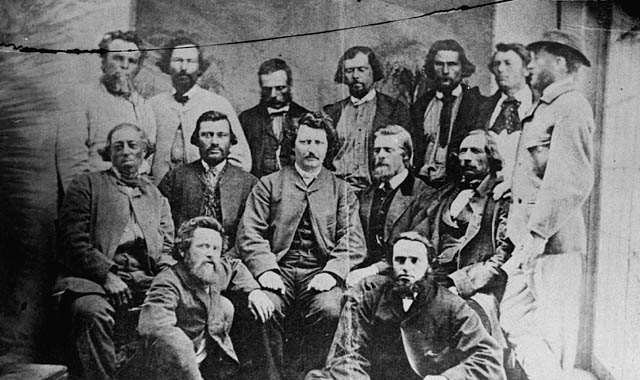
Meanwhile, a small force of Canadians gathered at Portage la Prairie, hoping to enlist support in the Scottish parishes of Red River and disband the provisional government. The appearance of armed Canadians alarmed the Métis, who promptly rounded them up and imprisoned them at Upper Fort Garry. The Métis convened a court martial at which Riel's associate, Ambroise-Dydime Lépine, sentenced a young Orangeman, Thomas Scott, to death by firing squad. Scott was executed on 4 March 1870. While this event was downplayed in both the Provisional Government of Assiniboia’s deliberations and by the Canadian leadership negotiating with the provisional government’s representatives in Ottawa, the execution did radicalize Protestant Ontario, who from this point onward sought retribution from Riel for Scott’s death.

Despite opposition from the Orange Lodge of Ontario, of which Thomas Scott had been a member, the provisional government’s delegates obtained an agreement with the Canadian government. The agreement was embodied in the Manitoba Act, which received royal assent on 12 May 1870, when the Province of Manitoba entered Confederation. Central to this agreement, the federal government agreed to reserve 1.4 million acres (566,560 hectares) for the children of Métis residents of Manitoba and ensured that the province would be officially bilingual.
To reassure Ontario and support the administration of the new Lieutenant-Governor A.G. Archibald, the federal government sent a military force to Red River under Colonel Garnet Wolseley in the summer of 1870. Though the Red River Expedition was supposed to be "an errand of peace," according to Archibald, the provisional government had not consented to its arrival, and it was not part of the agreement made by the delegation to Ottawa. Riel had reason to fear its arrival; the provisional government even considered resisting it. However, when it became obvious that the expedition was out to lynch Riel, he fled to the United States. On 3 May 1871, he returned quietly to his home in Saint-Vital, Red River, although he often stayed in hiding. When the province was threatened in the autumn of 1871 by a Fenian raid from the United States, Riel offered to organize a force of Métis cavalry to demonstrate Métis commitment to their agreement with Canada.
The Intervening Years: Quebec to Montana
In Ontario, Riel was widely denounced as Thomas Scott's "murderer" and a reward of $5,000 was offered for his arrest. In Quebec, he was regarded as a hero, a defender of the Roman Catholic faith and French culture in Manitoba. Anxious to avoid a political confrontation with the two principal provinces of Canada, Sir John A. Macdonald tried to persuade Riel to remain in voluntary exile in the United States, even providing a cash payout to Riel, who needed the money to support his family. However, his exile lasted only four months, and Riel was encouraged by his friends and his widespread popularity in French Manitoba to enter federal politics. He was elected in the federal riding of Provencher in a by-election in October 1873. Riel was re-elected in the February 1874 general election, at which point he travelled to Ottawa and signed the members’ register at the House of Commons (see Member of Parliament). But before taking his seat, he was expelled from the House on a motion introduced by the Ontario Orange leader Mackenzie Bowell. Although re-elected in a constituency by-election in Provencher in September 1874, Riel delayed in taking his seat and was later expelled from the House.
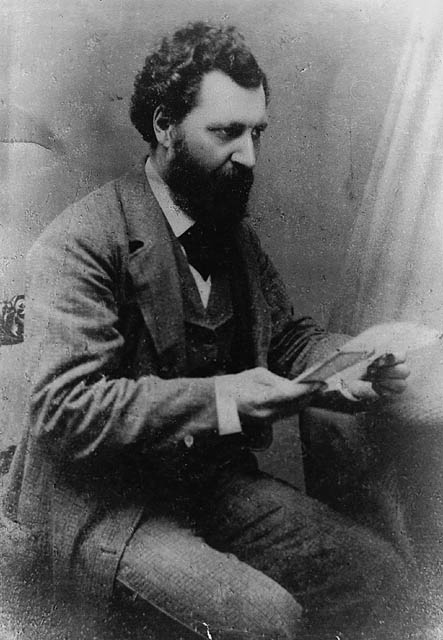
On 12 February 1875, the federal government adopted a motion granting amnesty to Riel that was conditional to five years of banishment from "Her Majesty's Dominions." The question of whether or not Riel had broken either British or Canadian law for his part in the Red River resistance was never determined in court (see Wilfrid Laurier: Speech in Defence of Louis Riel, 1874).
Shortly after his exile, Riel suffered a nervous breakdown and his friends secretly admitted him to hospital, against his own wishes, at Longue Pointe in Montreal. He was later transferred to the mental asylum at Beauport, Quebec. In January 1878, Riel went to Keeseville, New York, before travelling to the American Midwest. Between 1879 and 1883, in Montana Territory, he reintegrated himself with the Métis, joined the Republican Party, became an American citizen, and married a Métis woman, Marguerite Monet, dit Bellehumeur. In 1883, he also became a schoolteacher at Saint Peter's Mission, located on the Sun River.

In June 1884, Riel was asked by a group of Métis to help them protect their legal rights in the Saskatchewan Valley. Led by Gabriel Dumont, this delegation asked Riel to travel north to utilize his expertise in dealing with the Canadians for the benefit of the Métis people. Riel consented, so long as his family could join them and that he would be able to return to Montana once things were settled in Saskatchewan. With every intention of returning to Montana, Riel and his family reached Batoche, the main centre of Métis settlement in Saskatchewan, in early July. Riel conducted a peaceful agitation there, speaking throughout the district and preparing a petition. Among other grievances, the Métis were concerned by the fact that they did not hold permanent title to their land. Non-Aboriginal farmers were also dissatisfied with their lot and took issue with low wheat prices, high freight costs and tariffs on farming machinery. They were especially upset that their settlements were not reached by the new Canadian Pacific Railway. Riel and William Henry Jackson — secretary of the Prince Albert area farmers' union and Riel’s secretary — drafted a petition outlining these grievances in December 1884. This petition, preceded by some 40 others sent before Riel’s arrival, was acknowledged by the federal government, which promised to appoint a commission to investigate and report on problems in the West. However, similar statements had been made before, and the Saskatchewan Métis, many of whom had left Manitoba after the Canadian government’s failure to live up to its agreements, were wary of such promises.
The Provisional Government of Saskatchewan
By 1885, the North-West Mounted Police had been established, and a railway to the West almost completed, so the impetus for the Canadian government to negotiate with Métis as it had in 1870 was no longer present. Tired of waiting on Canadian action, the Batoche Métis, at a meeting on 5 March 1885, proposed to take up arms in order to compel Canada to recognize their land rights. At a meeting on 8 March 1885, Riel put forth a motion to create a provisional government for Saskatchewan. While the motion did not pass at that meeting, a 10-point "Revolutionary Bill of Rights" was drafted. It asserted Métis rights of possession to their farms, among other demands, including, "That the Land Department of the Dominion Government be administered as far as practicable from Winnipeg, so that the settlers may not be compelled as heretofore to go to Ottawa for the settlement of questions in dispute between them and the land commissioner."
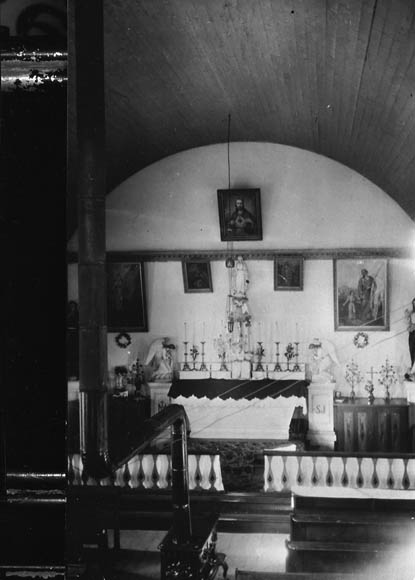
After word was received that the federal government was sending 500 soldiers to Batoche in answer to the Métis petitions, on 18 March the Métis seized the parish church at Batoche, formed a provisional government — of which Riel was president — and demanded the surrender of the HBC post at Fort Carlton. The ensuing fighting lasted two months (see North-West Resistance), and although the Métis won the first of two engagements, the Canadians ultimately overwhelmed Métis soldiers, and Riel surrendered himself to the Canadian militia.
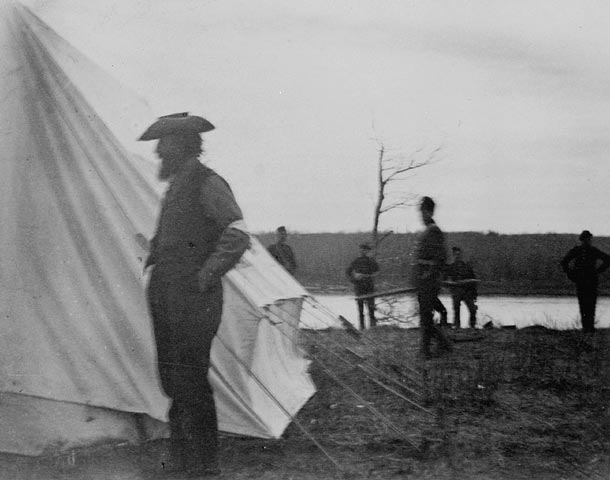
Trial and Execution
On 6 July 1885, a formal charge of treason was laid against Riel. On 20 July, his trial began in Regina. Against Riel’s wishes, his counsel defended Riel on the grounds of insanity, pointing to the time he spent in asylums in the late 1870s. Riel, however, understood that by casting him as insane, his lawyers would discredit his people’s legitimate grievances against the Canadian government. Riel wished to pursue a claim of self-defence instead, arguing that Métis actions in both 1870 and 1885 were justifiable. Riel, however, could not afford his own defence, and so his counsel was paid for by friends in Quebec, who likely had different motives than Riel. Repeatedly at odds with his lawyers throughout the proceedings, Riel ended his trial with an eloquent speech that systematically dismantled his lawyers’ insanity-defence strategy. This speech proved Riel’s sanity — it also all but assured that he would hang.
With the foreman in tears, the jury pronounced Riel guilty. While the jury recommended clemency, none was forthcoming. The verdict was appealed to the Court of Queen's Bench of Manitoba and to the Judicial Committee of the Privy Council. Both appeals were dismissed, but public pressure, particularly from Quebec, delayed execution pending an examination of Riel's mental state. The three examining physicians found Riel "excitable," but only one considered him insane. Owing to questionable excisions, the official version of the report did not reveal any difference of opinion and the federal Cabinet decided in favour of hanging.
Riel was executed on a public gallows in Regina on 16 November 1885. His body was transported to Saint-Boniface, where his remains were taken to the cathedral’s cemetery at the head of a massive procession made up of the leaders of French Manitoba. His grave, as well as his home, remain well-visited historic sites to this day.
Legacy and Significance
Politically and philosophically, Riel's execution has had a lasting effect on Canadian history. Riel’s execution made him the martyr of the Métis people. In Central Canada, the political fallout from Riel’s hanging enlivened French Canadian nationalism, propelling Honoré Mercier, who came to power in Quebec in 1886 on a platform that played to the feelings aroused by Riel's hanging. Riel’s death also caused a fundamental shift in Quebec voting trends, moving the province’s traditional support of the Conservative Party to the Liberal Party led by Wilfrid Laurier. Riel's execution remains a contentious issue, and demands for his posthumous pardon have been made on a number of occasions. Far from the days where Riel was a hated “traitor” and the “murderer” of Thomas Scott, Riel has been recognized as a Father of Confederation, as a wronged man, as a defender of his people, and as a protector of minority rights in Canada.
Riel has a number of statues commemorating him in his home province. In 2007, Manitoba recognized him with a public holiday held annually in February. For the Métis, 16 November, the day of Riel’s execution, is a national public commemoration of Riel’s life and the struggles he led. Riel still remains the most famous Métis leader and an important figurehead for Métis people in Western Canada.
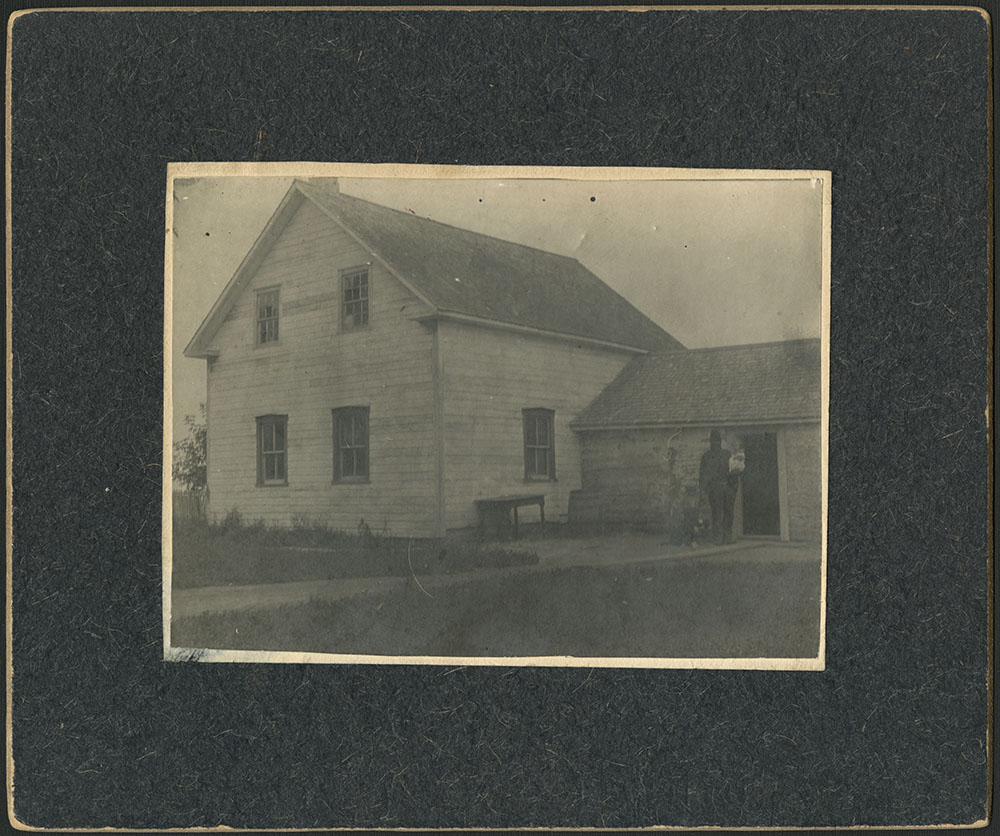
Riel’s place in Canadian history is more celebratory than in the past. For many, Riel has become a Canadian hero, as he embodies many contemporary issues in the country — bilingualism, multiculturalism, tolerance for difference, a keen sense of social justice — than many of his contemporaries. However, writers often ignore that Riel was very cautious of the Canadian national project, seeing it as assimilatory as much as unifying. Métis scholars now critique the zeal with which Riel has been Canadianized and how this appropriation is often at odds with Riel’s political beliefs, which featured a prominent place for Métis nationalism and political independence.
In 2016, the government of Manitoba recognized Riel as the first leader of Manitoba. In 2023, the government of Manitoba, through the Louis Riel Act, granted the honorary title of “First Premier of Manitoba” upon Riel. The act also required the minister in charge of The Education Administration Act to take steps to include Riel’s contributions to Manitoba and his honorary title in educational curricula.
Historiography and the Issue of Madness
The story of Riel has endured dramatic shifts since the 1960s. While Riel’s legacy has always been controversial — loved by some, hated by others — his status as a rebel, highlighted by many non-Métis historians and political scientists, has been largely replaced by the recognition that Riel was a visionary whose principles resonate with many Métis and Canadians today. Métis writers have been instrumental in reclaiming Riel’s narrative through many historical and cultural works. As a result, he is increasingly praised for his multiculturalism and multilingualism — both of which were contained in the original vision of Manitoba (see Manitoba Act).
Riel’s disputed insanity is less of an explanatory factor for scholars and popular writers today than it was previously. While his time in asylums is often left open to interpretation in many writings, the obsession with Riel’s supposed insanity and caricaturized spiritual mission have been increasingly understood in the context of their time, and the cultural context of Métis religiosity. Several scholars have noted that it was usually Riel’s friends, rather than his enemies, who attempted to cast him as insane, and that among his contemporaries, his “insanity” was regularly contested; many thought he was simply extreme, radical, or excitable — none of which made him crazy.

 Share on Facebook
Share on Facebook Share on X
Share on X Share by Email
Share by Email Share on Google Classroom
Share on Google Classroom
